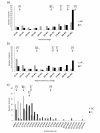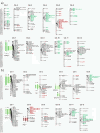Localization of QTLs for in vitro plant regeneration in tomato
- PMID: 22014149
- PMCID: PMC3209458
- DOI: 10.1186/1471-2229-11-140
Localization of QTLs for in vitro plant regeneration in tomato
Abstract
Background: Low regeneration ability limits biotechnological breeding approaches. The influence of genotype in the regeneration response is high in both tomato and other important crops. Despite the various studies that have been carried out on regeneration genetics, little is known about the key genes involved in this process. The aim of this study was to localize the genetic factors affecting regeneration in tomato.
Results: We developed two mapping populations (F2 and BC1) derived from a previously selected tomato cultivar (cv. Anl27) with low regeneration ability and a high regeneration accession of the wild species Solanum pennellii (PE-47). The phenotypic assay indicated dominance for bud induction and additive effects for both the percentage of explants with shoots and the number of regenerated shoots per explant. Two linkage maps were developed and six QTLs were identified on five chromosomes (1, 3, 4, 7 and 8) in the BC1 population by means of the Interval Mapping and restricted Multiple QTL Mapping methods. These QTLs came from S. pennellii, with the exception of the minor QTL located on chromosome 8, which was provided by cv. Anl27. The main QTLs correspond to those detected on chromosomes 1 and 7. In the F2 population, a QTL on chromosome 7 was identified on a similar region as that detected in the BC1 population. Marker segregation distortion was observed in this population in those areas where the QTLs of BC1 were detected. Furthermore, we located two tomato candidate genes using a marker linked to the high regeneration gene: Rg-2 (a putative allele of Rg-1) and LESK1, which encodes a serine/threonine kinase and was proposed as a marker for regeneration competence. As a result, we located a putative allele of Rg-2 in the QTL detected on chromosome 3 that we named Rg-3. LESK1, which is also situated on chromosome 3, is outside Rg-3. In a preliminary exploration of the detected QTL peaks, we found several genes that may be related to regeneration.
Conclusions: In this study we have identified new QTLs related to the complex process of regeneration from tissue culture. We have also located two candidate genes, discovering a putative allele of the high regeneration gene Rg-1 in the QTL on chromosome 3. The identified QTLs could represent a significant step toward the understanding of this process and the identification of other related candidate genes. It will also most likely facilitate the development of molecular markers for use in gene isolation.
Figures


Similar articles
-
Identification and validation of QTLs for salt tolerance during vegetative growth in tomato by selective genotyping.Genome. 2001 Jun;44(3):444-54. Genome. 2001. PMID: 11444704
-
Genetic analysis of Na(+) and K (+) concentrations in leaf and stem as physiological components of salt tolerance in Tomato.Theor Appl Genet. 2008 Apr;116(6):869-80. doi: 10.1007/s00122-008-0720-8. Epub 2008 Feb 5. Theor Appl Genet. 2008. PMID: 18251001
-
Identification of heat-tolerance QTLs and high-temperature stress-responsive genes through conventional QTL mapping, QTL-seq and RNA-seq in tomato.BMC Plant Biol. 2019 Sep 11;19(1):398. doi: 10.1186/s12870-019-2008-3. BMC Plant Biol. 2019. PMID: 31510927 Free PMC article.
-
Current Status of Early Blight Resistance in Tomato: An Update.Int J Mol Sci. 2017 Sep 21;18(10):2019. doi: 10.3390/ijms18102019. Int J Mol Sci. 2017. PMID: 28934121 Free PMC article. Review.
-
The genetic basis of fruit morphology in horticultural crops: lessons from tomato and melon.J Exp Bot. 2014 Aug;65(16):4625-37. doi: 10.1093/jxb/eru017. Epub 2014 Feb 11. J Exp Bot. 2014. PMID: 24520021 Review.
Cited by
-
Cellular, Molecular, and Physiological Aspects of In Vitro Plant Regeneration.Plants (Basel). 2020 Jun 1;9(6):702. doi: 10.3390/plants9060702. Plants (Basel). 2020. PMID: 32492786 Free PMC article. Review.
-
The role of a pollen-expressed Cullin1 protein in gametophytic self-incompatibility in Solanum.Genetics. 2014 Feb;196(2):439-42. doi: 10.1534/genetics.113.158279. Epub 2013 Nov 15. Genetics. 2014. PMID: 24240530 Free PMC article.
-
Vigor for in vitro culture traits in S. melongena × S. aethiopicum hybrids with potential as rootstocks for eggplant.ScientificWorldJournal. 2014 Jan 27;2014:702071. doi: 10.1155/2014/702071. eCollection 2014. ScientificWorldJournal. 2014. PMID: 24592179 Free PMC article.
-
Effects of Different β-Lactam Antibiotics on Indirect Tomato (Solanum lycopersicum L.) Shoot Organogenesis and Agrobacterium tumefaciens Growth Inhibition In Vitro.Antibiotics (Basel). 2021 Jun 1;10(6):660. doi: 10.3390/antibiotics10060660. Antibiotics (Basel). 2021. PMID: 34205842 Free PMC article.
-
Ornithine decarboxylase genes contribute to S-RNase-independent pollen rejection.Plant Physiol. 2021 May 27;186(1):452-468. doi: 10.1093/plphys/kiab062. Plant Physiol. 2021. PMID: 33576789 Free PMC article.
References
-
- Bhatia P, Ashwath N, Senaratna T, David M. Tissue culture studies of tomato (Lycopersicon esculentum) Plant Cell Tissue Organ Cult. 2004;78:1–21.
-
- Engelmann F. In vitro conservation of tropical plant germplasm. Euphytica. 1991;57:227–243. doi: 10.1007/BF00039669. - DOI
-
- Benson EE. Special symposium: In vitro plant recalcitrance: An introduction. In Vitro Cell Dev Biol Plant. 2000;36:141–148. doi: 10.1007/s11627-000-0029-z. - DOI
-
- Hamza S, Chupeau Y. Re-evaluation of conditions for plant regeneration and Agrobacterium-mediated transformation from tomato (Lycopersicon esculentum) J Exp Bot. 1993;44:1837–1845. doi: 10.1093/jxb/44.12.1837. - DOI
-
- Frary A, Earle ED. An examination of factors affecting the efficiency of Agrobacterium-mediated transformation of tomato. Plant Cell Rep. 1996;16:235–240. - PubMed
Publication types
MeSH terms
Substances
LinkOut - more resources
Full Text Sources
Research Materials
Miscellaneous

